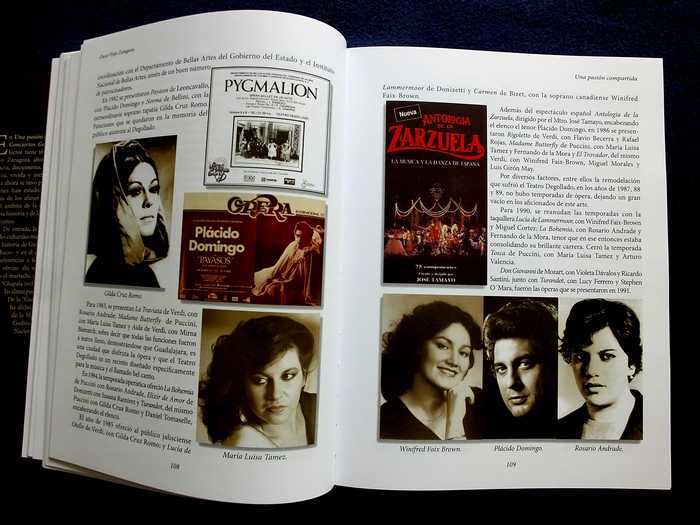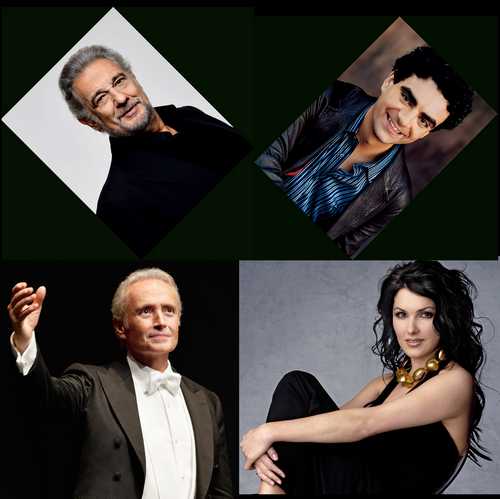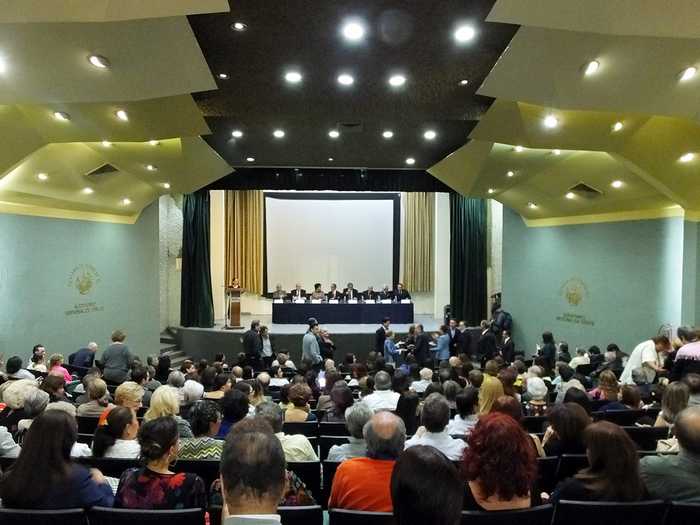|

The first 200 pages of this book are filled with nostalgic posters and
photos recalling concerts and operas featuring the most famous artists
in the world.
By John Pint
There was standing room only at the Guadalajara Chamber of Commerce auditorium on
Friday, March 10, 2017 for the presentation of a book outlining the history
and contributions of Conciertos Guadalajara, the organization
which—since the founding of the Symphony Orchestra in 1916—has been
bringing the world’s most famous soloists to the Degollado Theater and
hundreds of other venues in Jalisco.
 Una Pasión Compartida (A Shared Passion) is a collector’s item, an
elegant 656-page hardback by Oscar Trejo Zaragoza, playwright and
Editorial Coordinator of Editorial Agata, which published the book.
About 200 pages of this beautifully printed tome review the history of
the Guadalajara Concerts Association, its ups and downs, challenges and
solutions and the people in the background who made it all happen. This
section contains hundreds of posters and photos—many in color—of world
renowned artists such as Pablo Casals, Jaschi Heifetz, Claude Bolling,
Andrés Segovia, Gary Karr, Narciso Yepes, Facundo Cabral, Benjamin
Britten and many others of the outstanding musicians who were brought
to Jalisco by the organization. The rest of the book is dedicated to
Activities, in form of the most memorable programs of events occurring
between 1951 and 2009.
Una Pasión Compartida (A Shared Passion) is a collector’s item, an
elegant 656-page hardback by Oscar Trejo Zaragoza, playwright and
Editorial Coordinator of Editorial Agata, which published the book.
About 200 pages of this beautifully printed tome review the history of
the Guadalajara Concerts Association, its ups and downs, challenges and
solutions and the people in the background who made it all happen. This
section contains hundreds of posters and photos—many in color—of world
renowned artists such as Pablo Casals, Jaschi Heifetz, Claude Bolling,
Andrés Segovia, Gary Karr, Narciso Yepes, Facundo Cabral, Benjamin
Britten and many others of the outstanding musicians who were brought
to Jalisco by the organization. The rest of the book is dedicated to
Activities, in form of the most memorable programs of events occurring
between 1951 and 2009.
The production of this book, says Trejo, involved “rising at the crack
of dawn, working nonstop throughout the day and staying up all night
long.”
“So why did you do it?” he was asked by El Informador. “Well, it was a
hard job,” he replied, “but somebody had to put on paper what we have
accomplished here in Guadalajara, to demonstrate that there is
something else that is really ours apart from mariachis and tequila.
Jalisco has been generating great cultural richness and this should not
be ignored. Those of us who played a role in the history of Conciertos
Guadalajara know what we have done, but we will not live forever. Some
years from now this organization could be forgotten, so now is the time
to create a testimonial and that is what this book is.”
Conciertos Guadalajara was first known as La Sociedad de Conciertos y
Amigos de la Música when it was founded in 1919 by local people
enthusiastic about promoting the fine arts. Many of the events it
sponsored over the decades have been free of charge, such as the
international festivals held in the cathedral. The organization also
presented free concerts outside Guadalajara with the proposal of
bringing culture to every corner of the state. To help pay for such
projects, they organized presentations by the extremely popular Vienna
Boys’ Choir and the Rondalla de Saltillo students’ band. Supporting the
efforts of Conciertos Guadalajara, says Trejo, “many musicians played
in the city out of pure good will, charging not even 5 percent of what
they would usually receive. Just one example is Mexican tenor Fernando
de la Mora.” This explains how it was possible for Tapatíos to enjoy
operas featuring Plácido Domingo for an entrance fee of only ten pesos.
On other occasions, when it was necessary to raise funds to bring in
less altruistic big-name soloists, the Association turned to several
women (Teresa Casillas Hernández, María Teresa Santos Rooojo de Oroz
and Martha González de Hernández Allende) who worked tirelessly to
promote classical music in Guadalajara
over the decades. For example, says Trejo, when it was discovered that
Arthur Rubinstein charged two thousand dollars for a performance, the
Association turned to one if its greatest supporters, Teresa Casillas,
who commented:
“Rubinstein was the most expensive of all the artists I brought here
and I had to perspire a lot to make it happen. When we were
negotiating, they asked me what sort of guarantee they would have that
his honorarios would actually be paid. I replied, ‘It is I who am
contracting him—what more do you want?’ And they didn’t say another
word—but I was trembling and my knees were knocking as I hung up the
phone, because the truth was that I didn’t have enough money even to
pay the orchestra. So I asked the owner of the Alameda Theater if we
could hold the event there (for free), because it had far more seats
than the Degollado. Then we charged four times the usual admission
fees. Well, we sold every last seat, so I was able to pay both both the
artist and the orchestra and to take Rubinstein out to dinner, and
still we had money left over!”
On the night of the book launching, I asked people to talk about some
of the great performances they had witnessed at the Degollado.
Guadalajara muralist Jorge Monroy said, “I really enjoyed some of the
great musicians from Argentina who played here, for example Les
Luthiers and the guitarist Atahualpa Yupanqui. I also cannot forget the
poet and singer Alfredo Zitarrusa, from Uruguay.”
Said heart surgeon Carlos Juárez: “I remember Conciertos Guadalajara
from my childhood and the great artists they brought here, for example
Jean-Pierre Rampal and his solid gold flute and Narciso Yepes with his
ten-string guitar, and the temperamental violinist Ruggiero Ricci and
dozens and dozens of others...and the Requiems of Verdi or Mozart, all
a crucial part of my life!”
And here are some of the memories of Doctor Roberto Pérez:
“I will never forget when the ballerina Anna Pavlova came here. What a
performance she gave! Every seat in the Degollado was filled. Another
of our favorites was José Tamayo’s Anthology of the Zarzuela, which
came here from Madrid. It was stupendous, extraordinary. And then there
was the concert by Ravi Shankar. Another unforgettable
evening was when Duke Ellington came to town. The Jazz musicians walked
up to the stage through the aisles, playing their instruments. It was
truly apotheotic! I also remember the performance of virtuoso violinist
Ruggiero Ricci. He could barely walk, but this was utterly forgotten
the moment he began to play his Paganini variations. I do
believe it would be impossible to name any great musician who hasn’t
performed here in Guadalajara and all of them, every great soloist who
graced the Degollado, were brought here by this organization,
Conciertos Guadalajara.”
Dr. Pérez’
wife Marichuy Rodríguez said, “I can’t name a favorite. Each one of
them was simply the very best in the mastery of their instrument and
their style. I’ve been a member of the Ladies Committee which has been
assisting Conciertos Guadalajara for around 40 years and I can tell you
this organization is incredible, truly unique in Mexico. And, as for
this book, it is the register of a Golden Age of music lasting some 70
to 80 years. It is simply an emotional experience to page through it,
looking at the programs and reliving those wonderful experiences.”
When
I put my question to violinist-violist Robert Nelson, whose name
appears on many of the programs in Trejo’s book, I got a point of view
different from that of the concert-goer. “I can’t forget Jean-Pierre
Rampal’s visit here,” he told me. “I can still see him leaning over me,
breathing down my neck and saying, ‘You must do it this way, this way!’
And then there was the visit in 2010 of Anshel Brusilow, the great
concertmaster of the Philadelphia Orchestra. Brusilow is one of the
very best directors of Beethoven’s work, but after a full week of
rehearsals, he turned to me and said, ‘Enough Beethoven! Do you know
anyone who plays Bridge?’ So I told him I sometimes play Oh Hell with
friends in Pinar de la Venta, and off we went for a great evening at Rancho Pint. On
the way back to Guadalajara, I asked Brusilow if he was violin soloist
in a certain 1970 recording of Respighi’s music which I particularly
love. ‘Yeah,’ he replied, that would be me.’ Well, never in my life did
I imagine I would someday be playing cards with the man who made that
music which I so admired all those many years ago. By the way, speaking
of Pinar de la Venta, it’s the home of Joel Vandroogenbroeck, a pioneer
in electronic music who was invited to play a jazz-new-age-ambient
concert at the Degollado in 1996 together with maestro José Guadalupe
Flores...another first.”
The fact that this book’s chronicle
ends in 2009 tells us something. Is that when the Golden Age of music
ended? The University of Guadalajara’s Maestro José Manuel Jurado
addressed this very question during the book launching. What does this
monumental tome represent for Guadalajara’s music scene? Is it Mozart’s
Requiem or Handel’s Hallelujah Chorus? Only time will tell. 
The auditorium was filled to overflowing.
|

